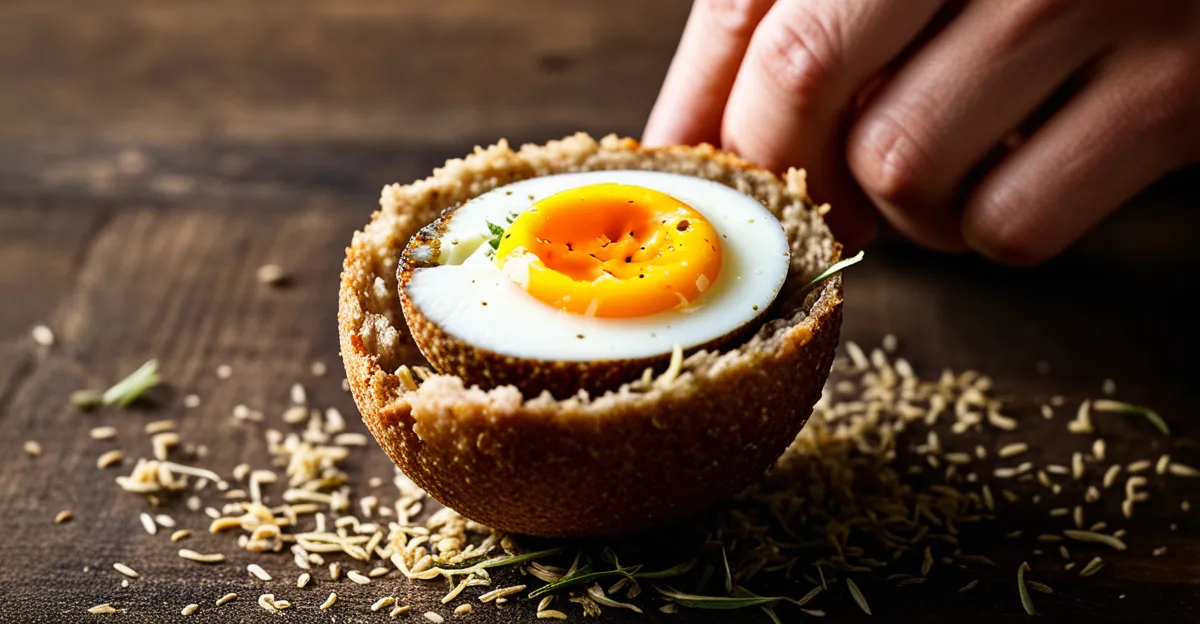Essential Ingredients and Tools
Creating traditional Scotch eggs demands a precise blend of authentic recipe basics and quality components. The core ingredients are simple yet crucial: firm-boiled eggs, fresh and flavorful sausage meat, crisp breadcrumbs, and a well-balanced mix of seasonings including salt, pepper, and herbs. Using high-grade sausage meat is essential to achieve both taste and texture—lean pork or a blend with mild fat offers the best results. Breadcrumbs should be coarse enough to add crunch but not so large that they detach during frying or baking.
To make Scotch eggs the traditional way, specific kitchen tools are indispensable. A sturdy saucepan is needed for boiling eggs to perfection. For shaping, a smooth surface helps evenly wrap the sausage meat around each egg. Also, a shallow dish or bowl for flour, beaten eggs, and breadcrumbs allows convenient and consistent coating. Finally, a deep fryer or a heavy-bottomed pan is essential for achieving the distinctive golden, crispy crust associated with classic Scotch eggs. These tools, combined with quality ingredients, form the foundation of an authentic recipe that respects tradition and ensures delicious results every time.
Have you seen this : What are the steps to creating a mouthwatering sticky toffee pudding?
Essential Ingredients for Authentic Scotch Eggs
Choosing the right authentic Scotch egg ingredients is fundamental for success. The base is always fresh, firm-boiled eggs with smooth shells to prevent cracking during preparation. The sausage meat must be of high quality—preferably pork with balanced fat content—ensuring juiciness without greasiness. Use coarse breadcrumbs that provide the traditional crunch and adhere well in the cooking process.
The traditional Scotch egg recipe also relies heavily on classic seasonings to enhance the flavors. A blend of salt, pepper, and herbs like thyme or parsley gives the sausage meat depth without overpowering the egg. Some recipes include subtle mustard powder or nutmeg to achieve an authentic flavor profile that is both savory and aromatic.
Also read : How Has British Cuisine Influenced Food Culture Globally?
Flour plays a critical but often overlooked role. It helps the sausage meat adhere more evenly around the egg and contributes to a crispier coating once fried. Precision in ingredient proportions and quality ensures the final Scotch egg balances moistness inside with a golden, crunchy outside. Mastery of these core elements guarantees a genuine taste and texture true to the traditional Scotch egg recipe.
Preparation Techniques for Traditional Scotch Eggs
Mastering the art of preparing Scotch eggs begins with precise egg boiling. To achieve the perfect doneness, boil large eggs for exactly 6 to 7 minutes in gently simmering water, ensuring a firm yet creamy yolk. Immediately transfer them to an ice bath to stop cooking and make peeling easier. This method prevents overcooking and splitting, both common issues during Scotch egg boiling.
Next, the sausage wrapping technique is crucial for a uniform, crack-free final product. Begin by flattening a portion of high-quality sausage meat into a thin, even layer large enough to encase the egg. Carefully roll the peeled egg in the meat, gently smoothing to eliminate air pockets, which reduces splitting during cooking. Consistent thickness in the sausage layer ensures even cooking and a satisfying texture.
Maintaining the egg’s integrity through careful handling and balanced cooking times prevents the yolk from becoming rubbery while the sausage cooks fully. These preparation techniques, emphasizing timing and gentle wrapping, are essential to replicating the satisfying bite characteristic of a true traditional Scotch egg recipe.
Coating and Cooking Methods for Scotch Eggs
Achieving the perfect breaded Scotch eggs begins with a meticulous coating process. Before applying breadcrumbs, dust each sausage-wrapped egg lightly in flour to create a dry surface that helps the egg wash adhere evenly. Then, dip in a beaten egg wash, which acts as the glue for the coarse breadcrumbs. This three-step coating—flour, egg wash, then breadcrumbs—ensures a durable crust that crisps beautifully during cooking.
For frying Scotch eggs, use a neutral oil with a high smoke point, such as vegetable or sunflower oil, heated to about 170-180°C (340-360°F). Maintaining this temperature avoids greasy or burnt crusts. Frying for approximately 5-7 minutes produces a golden-brown exterior and fully cooked sausage without overcooking the yolk. Alternatively, baking offers a lighter option: preheat the oven to 190°C (375°F) and cook on a greased tray for around 25-30 minutes, turning halfway for even browning.
Each method has merits: deep frying delivers the most authentic crispiness, while baking reduces oil usage and cleanup. Either way, mastering the coating and cooking technique is key to the signature crunch and rich flavor of a classic Scotch egg.










